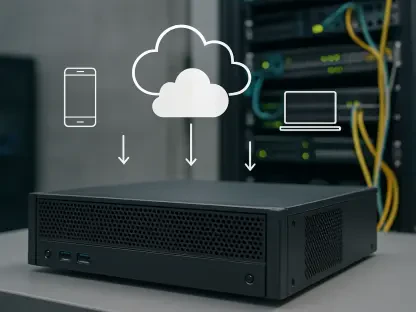In an era where digital threats loom larger than ever, the urgency to protect sensitive information across sprawling hybrid environments has become a top priority for organizations worldwide. Imagine a scenario where a single stolen credential grants attackers access to an entire network, allowing them to move undetected through cloud systems, on-premises servers, and countless endpoints, harvesting valuable data at will. This isn’t a distant possibility but a stark reality, as recent statistics reveal that 60% of breaches last year stemmed from compromised identities. With data constantly in motion—whether at rest, in use, or traversing between platforms—maintaining visibility and control is no longer optional but essential. Hybrid setups, blending cloud and traditional systems, amplify these challenges, leaving gaps that cybercriminals eagerly exploit. As businesses race to keep up, the question remains: how can organizations ensure robust security and compliance in such a complex landscape? This exploration dives into actionable strategies and tools to safeguard data wherever it resides.
1. Understanding the Stakes of Data Mobility
The digital landscape has evolved into a sprawling web of hybrid environments where data flows ceaselessly across cloud platforms, on-premises systems, and myriad devices. This mobility, while enabling flexibility and innovation, creates significant vulnerabilities that attackers are quick to target. A staggering 75% of organizations are projected to adopt hybrid cloud strategies by next year, according to industry forecasts, yet only a small fraction—about 23%—currently claim complete visibility into their cloud operations. Such limited oversight means sensitive information often slips through unseen cracks, making it ripe for exploitation. Identity-based attacks, in particular, have surged, with stolen credentials playing a role in a majority of recent breaches. These incidents highlight a critical need for comprehensive tracking of data in motion, at rest, and in use. Without a clear grasp of where information resides and how it moves, businesses remain one step behind cybercriminals who operate with ruthless precision.
Beyond the immediate threat of breaches, the financial and regulatory consequences of failing to secure data are daunting. Last year, the average cost of a data breach reached nearly $5 million, a figure that underscores the devastating impact on both budgets and reputations. On top of that, stringent regulations like the General Data Protection Regulation (GDPR) impose fines that can climb to €20 million or 4% of annual global turnover, whichever is higher. Emerging laws, such as Europe’s Digital Operational Resilience Act (DORA) and maturing privacy frameworks in Asia, add further pressure to maintain granular control over data. Regulators demand airtight security regardless of where information lives, and falling short turns compliance into costly guesswork. For global enterprises, staying ahead of these evolving standards isn’t just about avoiding penalties—it’s about embedding security into every facet of operations to prevent breaches before they occur.
2. Identifying Key Challenges in Hybrid Environments
Hybrid environments, while offering scalability and efficiency, introduce a host of data-tracking obstacles that can undermine even the most robust security measures. One of the most pressing issues is limited visibility across diverse systems, including cloud platforms, on-premises infrastructure, and a growing array of devices. When organizations can’t see the full scope of their data landscape, protecting it becomes nearly impossible, leaving blind spots for attackers to exploit. Identity risks compound this problem, as stolen credentials, session cookies, and API keys grant seemingly legitimate access to sensitive areas. Misconfigurations, such as exposed databases or overprivileged accounts, further widen the attack surface, often turning small oversights into catastrophic leaks. These vulnerabilities are not just technical—they reflect a broader struggle to maintain control in an increasingly fragmented digital ecosystem.
Adding to the complexity are legacy systems that often clash with modern cloud-native tools, creating interoperability gaps where security controls fail to keep pace. Data governance also suffers, especially when enforcing consistent audit trails and policies across mobile devices, bring-your-own-device (BYOD) setups, and sprawling Software-as-a-Service (SaaS) platforms. Without unified oversight, compliance becomes a patchwork effort, riddled with inconsistencies that regulators are quick to penalize. The stakes are heightened by the sheer volume of data businesses handle daily, often outpacing the capacity of siloed teams to manage it effectively. As attackers grow more sophisticated, capitalizing on these weaknesses, organizations must confront the reality that fragmented approaches to data protection are no longer sustainable. Addressing these challenges requires a shift toward cohesive strategies that prioritize visibility and adaptability across all environments.
3. Six Essential Steps to Fortify Data Protection
Building robust defenses in hybrid environments demands a structured approach to visibility and control, ensuring data remains secure no matter where it resides. The first step is to enhance identity protections by adopting a Zero Trust model, which verifies every access attempt and mitigates risks from compromised credentials. Next, restricting high-level access, particularly for executives and other high-value targets like the C-suite, minimizes compliance risks by limiting exposure of critical systems. Identifying and tracking sensitive data through data loss prevention (DLP) tools is also vital, enabling classification and monitoring across cloud and endpoints to stop leaks before they escalate. These initial measures lay a strong foundation for curbing unauthorized access and maintaining a clear view of information flows, addressing some of the most immediate threats in today’s digital landscape.
Beyond these starting points, standardizing dynamic policies ensures uniform access rules across hybrid setups, eliminating inconsistencies that attackers often exploit. Leveraging automation takes this further by enabling real-time policy updates at scale, neutralizing threats swiftly while reducing manual workloads for overstretched security teams. Finally, organizations should begin with imperfect progress, recognizing that starting somewhere—even with tradeoffs—is better than inaction. Implementing these practices may not yield overnight perfection, but they create a pathway to stronger security and compliance. Pairing these strategies with an effective DLP solution can accelerate progress, delivering quick wins and simplifying the journey toward airtight data protection. By focusing on these six steps, businesses can transform data security from a reactive burden into a proactive strength, staying ahead of both regulators and cybercriminals.
4. Leveraging Advanced Tools for Seamless Security
In the quest for comprehensive data protection, advanced tools play a pivotal role in simplifying the complexities of hybrid environments. Solutions like Symantec DLP stand out for their ability to seamlessly monitor sensitive information, ensuring compliance without adding operational headaches. Recognized as a top player by leading industry analysts, this platform excels at safeguarding data whether it’s in motion, at rest, or in use across diverse systems. Its advanced detection capabilities pinpoint risks with precision, while rapid classification helps organizations stay ahead of potential leaks. Easy integration with existing infrastructure further reduces manual effort, closing compliance gaps that might otherwise go unnoticed. For businesses grappling with sprawling data landscapes, such tools offer a lifeline, providing the visibility and control needed to mitigate threats effectively.
The benefits of adopting such technology extend beyond mere protection to enhance overall business continuity. With robust security measures in place, operations can proceed without interruption, even as cyber risks intensify. This allows security teams to shift focus toward broader initiatives, such as expanding Zero Trust principles for deeper compliance and resilience. By automating routine tasks and delivering actionable insights, these solutions free up resources for strategic planning, ensuring that data protection aligns with long-term goals. The result is a fortified environment where sensitive information remains secure, regardless of its location or the complexity of the systems housing it. For organizations aiming to balance innovation with security, investing in proven DLP technology represents a critical step toward achieving that equilibrium, fostering confidence in an increasingly perilous digital world.
5. Exploring Further Resources for Data Security
For those seeking to deepen their understanding of securing hybrid environments, additional resources offer valuable insights into cutting-edge practices. An on-demand webinar titled Navigating the Challenges of Securing Hybrid Environments provides a detailed look at applying Zero Trust principles to bolster data protection and compliance. This resource breaks down complex concepts into actionable takeaways, helping organizations tailor their strategies to unique operational needs. Exploring such content can illuminate practical ways to address visibility gaps and identity risks, reinforcing the importance of proactive measures in today’s threat landscape. It serves as a guide for businesses at any stage of their security journey, offering clarity on how to navigate the evolving demands of hybrid setups with confidence and precision.
Acknowledging the expertise behind these insights, credit goes to contributors like John Whelan, a Product Marketing Manager with deep knowledge of data protection strategies. Reflecting on past efforts, organizations that took early steps to engage with such resources often found themselves better equipped to handle breaches and regulatory scrutiny. Looking back, those who prioritized learning from industry leaders were able to implement solutions that not only mitigated risks but also streamlined compliance processes. Moving forward, the next actionable step is to dive into available materials, assess current security postures, and identify areas for improvement. By staying informed and leveraging expert guidance, businesses can build on past lessons to create a more secure future, ensuring data remains protected against ever-evolving threats.









